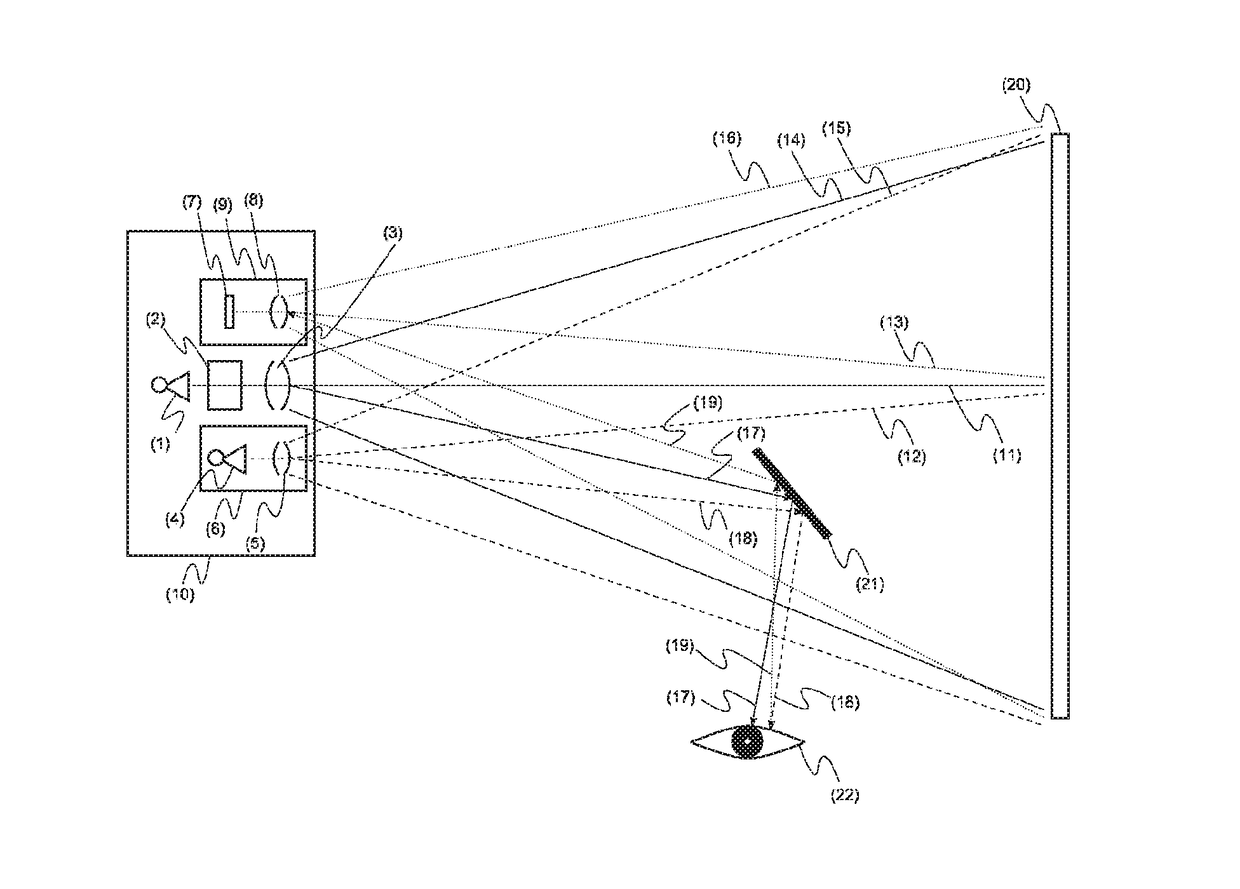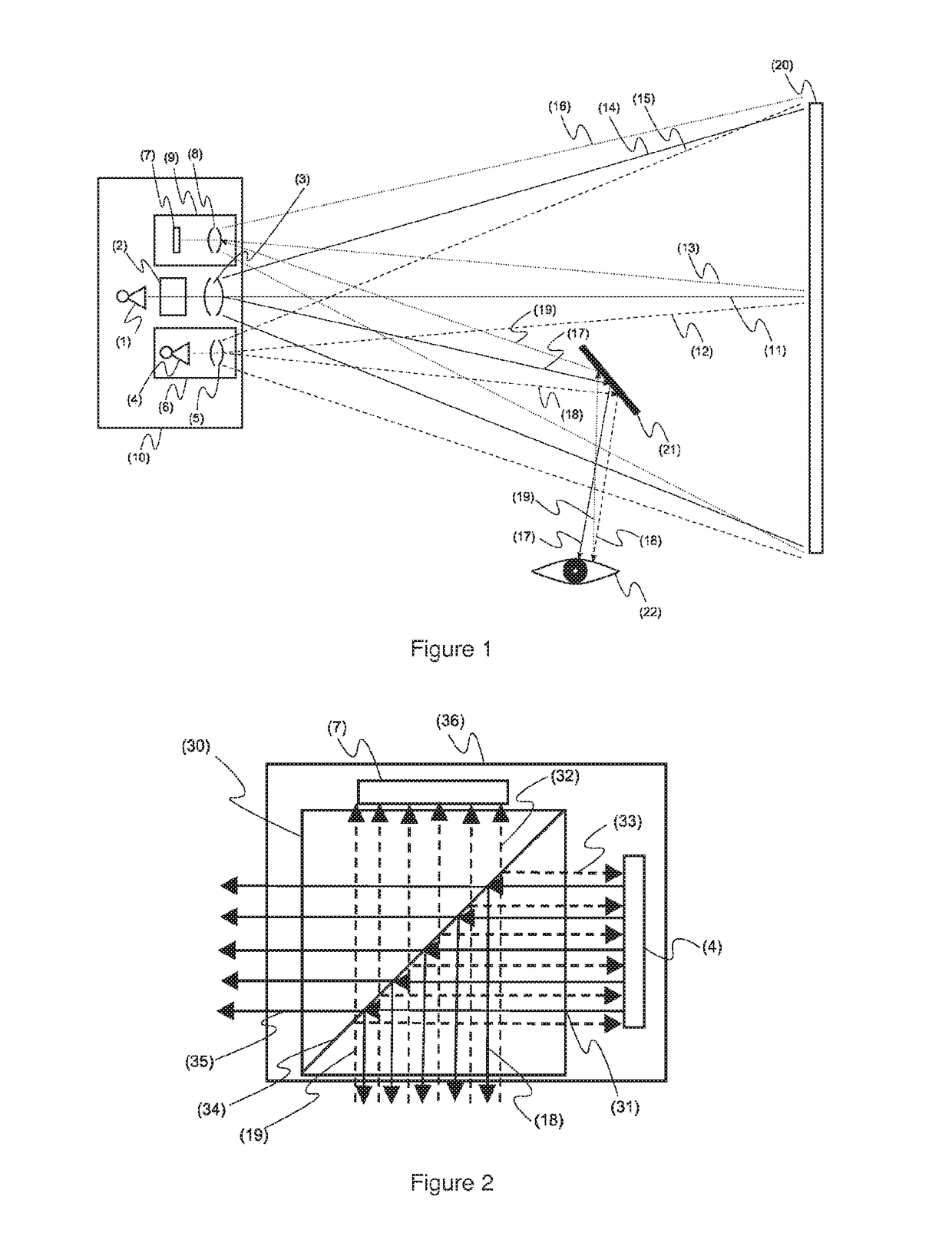Projection system with safety detection
a projection system and safety detection technology, applied in the direction of picture reproducers, picture reproducers using projection devices, instruments, etc., can solve the problems of stringent safety regulations restricting their use, excessive output power of laser sources, and easy blind spots
- Summary
- Abstract
- Description
- Claims
- Application Information
AI Technical Summary
Benefits of technology
Problems solved by technology
Method used
Image
Examples
first embodiment
[0058]As an optional first step towards specific embodiments of the invention, the optical axis of the detection sensor (7) or camera and the optical axis of the light from the detection light source (12) are made the same or even identical in a detection sub-system. In said detection subsystem, this is achieved by using an optical component such as for beam splitting of the detection light (18) and reflected detection light (19). FIG. 2 shows such a detection subsystem (36) with the detection light source (4), detection sensor (7) or camera and a beam splitter (30). The irradiated detection light (31) that is irradiated by the detection light source (4) is reflected internally in the beam splitter (30) on a partially reflective surface (34). The reflected detection light (19) that was reflected back from an object or the projecting surface (20) will enter the beam splitter and will partially (32) hit on the detection sensor or camera and partially be reflected (33) to the detection...
second embodiment
[0060]In the sub-system that makes the optical axis of the detection sensor (7) and detection light source (4) the same or even identical, use is made of an optical component such as photosensitive elements and detection light emitting elements that are integrated on a single semiconductor substrate. Such so called bidirectional sensors have been demonstrated by the Fraunhofer institute using green OLED emitters (http : / / www.oled-info.com / fraunhofer-shows-new-bi-directional-oled-microdisplay-can-measure-distances).
third embodiment
[0061]In said detection sub-system (see FIG. 3), the combination of the optical axes can be achieved by the use of an optical component such as a light guide (41) placed in front of the detection sensor (7) or camera. The light guide is based on similar technology as edge lit backlights. By adding a patterned dot structure (40) on the light guide it is determined where the light is coupled out from the light guide. Ideally this pattern is placed in the inactive areas between the sensor pixels of the detection sensor (7). Due to the small size of the detection sensor pixels it might be challenging to achieve this level of precision and alignment. Alternatively a random pattern of dots could be used. The dot size is preferably smaller than the size of a sensor pixel. It is important that the dot pattern directs the light as much as possible to the front so that the detection light (18) does not scatter back towards the detection sensor (7). The effect of this backscattering can be red...
PUM
 Login to View More
Login to View More Abstract
Description
Claims
Application Information
 Login to View More
Login to View More - R&D
- Intellectual Property
- Life Sciences
- Materials
- Tech Scout
- Unparalleled Data Quality
- Higher Quality Content
- 60% Fewer Hallucinations
Browse by: Latest US Patents, China's latest patents, Technical Efficacy Thesaurus, Application Domain, Technology Topic, Popular Technical Reports.
© 2025 PatSnap. All rights reserved.Legal|Privacy policy|Modern Slavery Act Transparency Statement|Sitemap|About US| Contact US: help@patsnap.com



